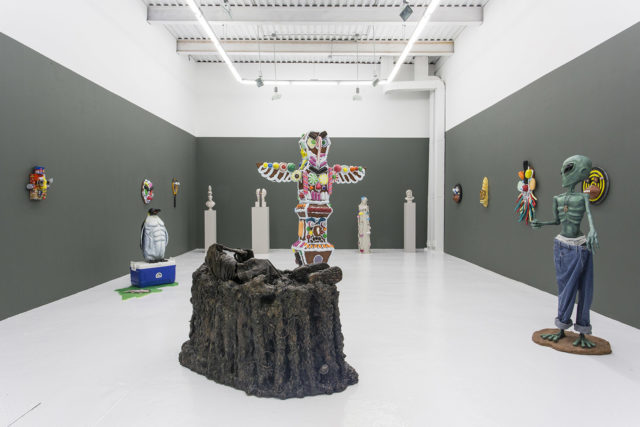
Theo Rosenblum and Chelsea Seltzer At the Hole. Installation view
Entering Theo Rosenblum and Chelsea Seltzer’s “Culture Shak” installation at The Hole, is like walking into a Post-human Natural History Museum arrangement of “2016.” The decadence, absurdity, and pleasures of our fragmented culture are put on display with a monumental gingerbread totem pole, a sexy penguin with a six-pack abs, and a touching sculpture of a volcanic ash encrusted skeleton.
I had the pleasure of sitting down with the zany duo, to discuss cultural appropriation and what interpretation a future alien race might bring to relics left behind by our own extinct species.
Irena Jurek: Tell me about the show. How was it conceived.
Theo Rosenblum: We were envisioning the show as being in a post-human museum. Like, what would happen if aliens found a chunk of earth floating in space and they made some sort of exhibit out of what they found?
You seem to be commenting on the role of art and how that role has shifted over time. Art’s main function was once religious and ritualistic, rather than the secular identity that it’s morphed into today. This seems to especially be true with the massive candy totem pole you built.
TR: For a good part of the show we were thinking about the museum show and its collection. If you go to the Met or the Natural History Museum’s African art or Pacific Islander section, for example, the context of the museum itself can separate the object from its original use. A mask that was used for ceremonial purposes, for example, ends up on display rather than being used in ceremony. It’s reproduced, too, so it’s on a calendar in somebody’s house or a bunch of knock offs are made. We were both interested in the journey of objects that were used in everyday life, become part of a museum display, but then make their way back to everyday use in the form of mass culture. Basically, we’re interested in what happens to objects when they lose their meaning and gain a new one.
And when it ends up in a store, the transformation usually precludes scholarship or reverence for the original culture. It’s just a look. Picasso’s appropriation of African art seems like a good analogue to me. He was much more interested in the aesthetic of African art rather than the meaning.
Chelsea Seltzer: Yes! The original culture is stripped away from it, and a new culture is put on top of it.
Even the way each generation views and interprets objects can be so different f. So much of the criticism of the 60s, for example, seems arcane now. The concepts you had for this show are bound to be interpreted differently than we do now by other generations.
CS: People often tell us that we’re time travelers when they look at our work. I really like the idea of being a time traveler trying to makes sense of all these pieces of culture. If you didn’t have the schooling or ability to verbalize what these things meant, how would you make sense of it?
You also fetishize the concept of the “original” by using found decorative plates, altering them, and transforming them from mass-produced objects to original art works.
TR: Definitely. In a lot of them we’re talking about how being Native American is perceived by others. The market for the image of a Native American holding up a buffalo skull isn’t Native Americans, for example. These images are made to be consumed by the culture at large.
And every culture has its myths. Americans tend to mythologize the idea of the West, the wilderness, and have a weird romanticized notion of Native Americans.
CS: Yes, and that clash is especially evident in our totem pole. The way we see it, this European tradition of gingerbread is taking over the native tradition of creating a totem pole.

Theo Rosenblum and Chelsea Seltzer “Ceremonial Victory Mask 1”, 2016, found objects, aqua resin, fiberglass, acrylic paint, 18 x 18 x 5.5 inches
There’s also a sense of pleasure and hedonism to your work as well.
CS: Food has always been a great part of what we’re drawn to and what we think about.
TR: We’ve always been attracted to food because it’s such a universal theme; everyone can relate to it.
CS: When we cover everything in candy, it transforms into a “feast of food!” Excess and consumption are such a large part of the ideas behind our work.
I can definitely see that. Your work always reminds me of Bergman’s Seventh Seal, in that although there’s this sense of fun, it still seems like death is always lurking around the corner, ready to ruin the party for everyone.
CS: Yes, it’s like those dark undertones we were talking about before. Something more sinister is always waiting for you beneath that playful or hedonistic cover.
But also, the construction of myths and narrative seem to be a focus.
TR: Definitely. People tend to want everything to have a purpose or a meaning. But what we know and the narrative that holds it all together can be very different. There’s lots of room for error.
CS: A lot of our work is about the uncomfortable feeling left behind when no interpretation is offered. Whatever narrative forms are fleeting—much like life.


Comments on this entry are closed.